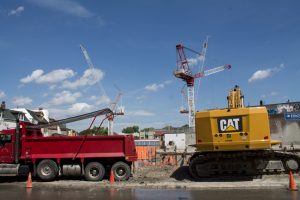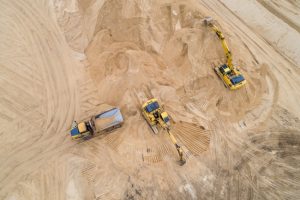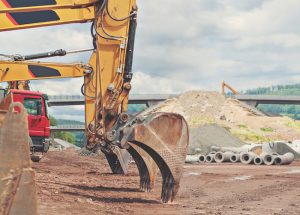
Creative solutions for fleet management
By Matthew Frankel
Construction Equipment FinancingLeveraging fleet data via telematics can help construction businesses address fleet scaling challenges to maintain a competitive edge.
Traditional fleet management strategies, including buying and leasing new fleets or maintaining a blend of older-and-newer fleet vehicles, did not perform optimally through the Covid pandemic and the recent cycle of supply chain issues and large swings in sales prices. In many cases, new vehicle deliveries were significantly delayed or simply unavailable. Rental fleet unit availability, a typical second option to buying, was also impacted.
Given these disruptions, many construction businesses are rethinking their fleet management strategies. For fleet management, an emerging scalable solution is the pay-per-use model. By leveraging technology to gather asset data, pay-per-use models can enable data-driven, supply-conscious and adaptable fleet management for construction businesses.
What is pay-per-use?
Pay-per-use is not a traditional lease, loan, or rental. It’s a contractual agreement between an equipment user and an asset owner based on how the asset is used. These arrangements can often be structured to ensure the user has the necessary capacity available to help them get their job done. Technology and data are at the core of the model.
As with other segments of the construction industry, technology is quickly becoming an essential part of one’s toolbox, especially technology that’s internet of things (IoT) enabled. IoT technologies are commonly used to track and share asset-level data.
A recent McKinsey & Company article explained that IoT technologies are part of the construction industry’s transformation and “give companies the ability to track and monitor utilization, energy efficiency, and maintenance needs.”
In the future, technology will also be essential for measuring and monitoring emissions to comply with new environmental standards.
Pay-per-use models are driven by IoT technology. This means they come complete with usage-based, data tracking capabilities from day one. The IoT technology that collects the asset-level data is telemetry hardware which is common in newer fleet vehicles or can be applied as a retrofit.
By leveraging usage data, pay-per-use models can capture the use and efficiency of each asset to inform better fleet management, and the data can be turned into billing events that more closely align a company’s revenue-and-cost activities.
There are many possible billing metrics based on fleet usage data, including distance travelled, hours of runtime, days in use or activities completed. When the asset is being used, the activity is captured, and the user is billed precisely. Usage data measurements should be correlated with units of value achieved when the asset is used. In other words, it should make sense to the company using the equipment.
Cost and revenue alignment
With the asset data, construction companies using pay-per-use solutions can align their costs with revenue and, in many cases, pay only when the asset is in use and generating revenue. For example, let’s say a construction business knew they needed to rent an excavator for a project. They need it for multiple days for different phases of the project, but are not sure of which exact dates, so they decide to rent it for one month. The one-month rental cost could be $6,800. So, how does that translate to the cost of actually using the excavator?
- If the business used the excavator for all 24 days, the cost would be $283 per day.
- If the business only used the excavator for 15 days, it would cost $453 per day.
Under the traditional one-month rental, the construction business will pay for the asset whether it is in use or not — there is a misalignment between cost and revenue for the actual work performed.
If the company knew it only needed the asset for 15 days, why would it agree to a monthly rental? There are few potential reasons. Perhaps it cannot predict specific days the asset is needed. Or maybe it needs to ensure the asset will be available when it’s needed.
Even with uncertainty of use, under a pay-per-use agreement, the construction business would have access to the asset(s) from the asset owner and would only be charged for actual usage. Pay-per-use models can also help construction businesses increase operating cost visibility by leveraging usage data to get an overall view of their operational costs. In many cases, there is also no upfront cash outlay with pay-per-use. Businesses only pay when the assets perform work and generate revenue.
And the model can also help with preventative fleet maintenance, as insights from pay-per-use models can help construction businesses facilitate preventative fleet maintenance and have better predictability of costs based on usage patterns. As part of the pay-per-use structure, service, maintenance, and extended warranty can be incorporated in the use payment, giving construction businesses administrative simplicity along with cost certainty.
Supply-conscious fleet expansion
Noted earlier, construction businesses often rent fleet assets. In addition to cost-and-revenue challenges, there can be other issues associated with rentals. For example, depending on the timing, certain fleet vehicle(s) may not be available. Project deadlines could get pushed back, and potentially increase costs and create customer service risks.
To mitigate fleet availability, many construction businesses rent fleet vehicles for a longer period. This means the business will pay when the fleet vehicles are not in use, resulting in additional overhead. Rental fees can also fluctuate based on demand, supply or other factors. The rent today may not be the rent tomorrow and this could mean cashflow and future budgeting challenges.
Under a pay-per-use model, the asset owner makes the equipment available to the pay-per-use customer for an agreed upon period of time. This is typically three to five years, which reduces asset availability risks. Pay-per-use costs are set for the contract term, provided usage is reasonably in line with targets. This reduces regular periodic rate increases that could cut into cashflow and operations planning. And the construction business may only pay when the asset is in use, enabling the user to budget for each job and reduce overhead.
Pay-per-use solutions are an opportunity for construction businesses to reflect on their current fleet management strategies and alternatives for the future. Do their current strategies align costs and revenue? Are they already tracking asset data? How are they measuring success? These kinds of reflections are an opportunity to think outside of the box and, in turn, to build a competitive advantage.
Matthew Frankel is the global head of pay-per-use solutions at DLL, an international asset finance company specializing in equipment and technology.







